Reading Time: 11 mins
A shorter version of this article titled "The Ruins of Nalanda University stand as a symbol of India’s glorious past" has been published in GoUNESCO.
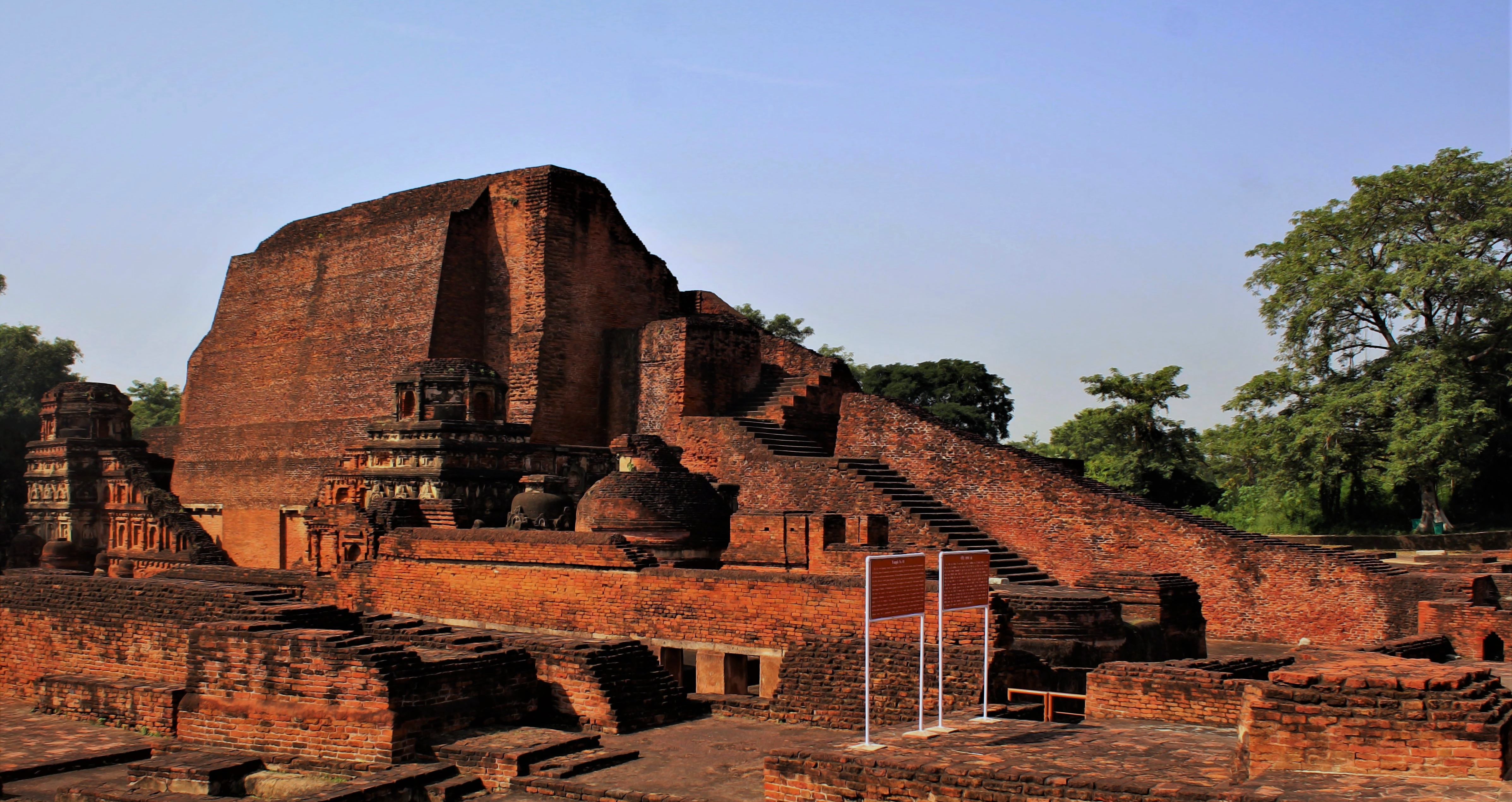
Following are the excerpts from two News Articles published by the BBC, a few years back-
India: Ancient university reopens after 800 years
“An ancient Indian university has reopened 800 years after it was destroyed in an invasion, it's been reported… The new campus is set to be spread over 443 acres (179 hectares) about 15km (9 miles) from where the original university stood”
01 Sep 2014; News from Elsewhere..., BBC Monitoring
India's ancient university returns to life
“It was an eminent centre of learning long before Oxford, Cambridge and Europe's oldest university Bologna were founded. Nalanda University in northern India drew scholars from all over Asia, surviving for hundreds of years before being destroyed by invaders in 1193.”
29 May 2013; BBC NEWS (www.bbc.com)
The articles talk about Nalanda University, which re-opened in Sep 2014…yes after 800+ years; it was destroyed in 1193. The news became the headline of many newspapers across the world. The idea of revival was proposed in 2006 by former President of India late APJ Abdul Kalam. The University came into existence by the Nalanda University Act passed by Parliament of India. Nobel laureate economist Amartya Sen was the first Chancellor of the University. Apart from the government of India, the University received grants / contributions from various countries like Singapore, Thailand, Australia etc. The new University is located in Rajgir at a distance of around 15 kms from the old one, and the old one…today you can see the remains only. It’s called Ruins of Nalanda University, currently well-maintained amidst a lot of open green spaces by Archaeological Survey of India (ASI). It attracts a large number of visitors from all over the world and recently (2016) it has been declared as a UNESCO World Heritage site.
Even after centuries of invasion and depletion of the structure, the ruins and the site still stand as a symbol of India’s glorious past. If you are inclined towards ancient Indian education and architecture, then a visit to the Ruins of Nalanda University must be on your travel list. The site would take around 2-3 hours to cover completely (although it depends on the person visiting, I have seen people who say that there is nothing to see in these ruins and can be wrapped up in 15 minutes). For me, it took around 2 hours. Just opposite to it you can see the Nalanda Archaeological Museum, which will take around 1 hour. Additionally, there are some other tourist spots (Black Buddha Temple is a must see) nearby and small refreshment stalls. So, while planning your trip, keep aside 4-5 hours for this place.

WHAT WAS NALANDA?
Situated in the Ancient State of Magadha (a part of modern-day Bihar State in India), Nalanda was a ‘Mahavihara’ (i.e. Great Monastery) – this term is used in almost all inscriptions on seals and copper-plate charters. Then why do we call it a University?
Well, the term ‘university’ didn’t exist that time. The term ‘university’ derives from Europe’s oldest university Bologna, founded in 1088 CE and chartered in 1158 CE. Nalanda was at its last stage that time and completely destroyed in 1193 CE. Foreign students in Bologna, grouped by nationality, hired scholars to teach them. This created an association of students from diverse nationalities, thus creating a ‘universitas’, which is the origin of the word ‘university’. Nalanda also attracted monk-students from places outside India, such as Japan, Indonesia, Persia, Turkey, China, Korea, Tibet etc.
- It was one of the greatest learning centres of that time and subjects taught included theology, grammar, logic, astronomy, metaphysics, medicine and philosophy (ASI)
- Inside the Nalanda compound there were 11 monasteries, an expansive library spread between three towers and an astronomical centre
- For residential monk-students and travellers/ visitors, there were around 300 rooms and 8 halls to host meetings and events
- In its peak, it had more than 1,500 teachers and scholars. Number of students were 10,000+
Aren’t these enough to call Nalanda a university? Off course they are when you talk in the context of a time 1500 years back.
“Nalanda University was a renowned centre of learning in Ancient India attracting students from different countries. It flourished long before Europe’s oldest university Bologna was founded”
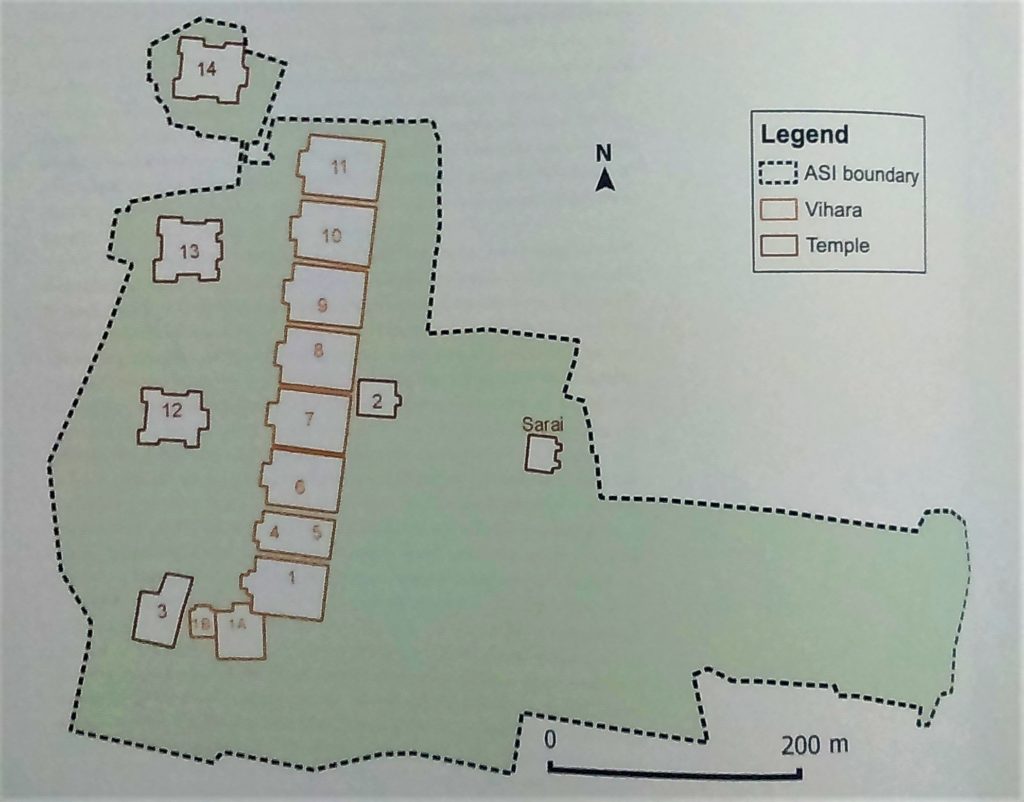
![IMG_2410 [ All the monasteries had similar features like central court, pillared verandah all around, rooms, provision for skylight, staircase and place for shrine. The fragments of stone pillars of its verandah still standing at their original position ]](https://www.myindiathrulenses.in/wp-content/uploads/2019/01/IMG_2410.jpg)
Remains of Monastery No. 11 [All the monasteries had similar features like central court, pillared verandah all around, rooms, provision for skylight, staircase and place for shrine. The fragments of stone pillars of its verandah still standing at their original position]
EXCAVATION WORK
In the 19th century, Dr. Francis Buchanon-Hamilton, a British officer, identified the site. Sir Alexander Cunningham, the founder of ASI, surveyed and provided a complete description of the site in 1860s. ASI began systematic excavation in 1915-16 that went for 20 years. The excavations have revealed evidence of construction on this site over different (at least three) periods.
WHAT THE EXCAVATION REVEALED?
- Structures: Excavations exposed remains of 6 temples and 11 monasteries (brick structures) arranged systematically over an area of more than a sq.km. There is a 30m wide passage running north to south with temples on the west and monasteries on the east side arranged in series. There is a main temple (temple 3) at the south, which was constructed in 7 phases. It is surrounded by small stupas.
- Sculptures: Excavations also found many sculptures of stone, bronze and stucco. Significant Buddhist sculptures are Buddha in different postures, Avalokiteswara, Manjushree, Prajnaparamita etc. Significant Hindu sculptures are Vishnu, Shiva-Parvati, Mahishasura-Mardini, Ganesha, Surya etc.
- Excavations also included several murals, copper plates, inscriptions, seals, coins and potteries.
One should explore the Nalanda Archaeological Museum (maintained by ASI) just opposite to the heritage site to see a rich display of sculptures, coins, seals and inscriptions that were conserved from the ruins.

Left: Sandstone Buddha; Right: Bodhisatva Avalokiteswara. 6th century CE sculptures obtained from the ruins of Nalanda University and preserved at Nalanda Museum. (Photographs taken with permission from the Museum)
EARLY HISTORY (6TH CENTURY BCE TO 5TH CENTURY CE)
The actual origin of Nalanda is however unknown, probably it started as a small monastery dating back to 6th century BCE. It, however, rose to its statute in 5th century, a millennium later. According to Xuan Zang (Hiuen Tsiang), one of the Buddha’s two closest disciples Sariputra died at the town of Kalipinaka about 30 kms from Nalanda. He states that Mauryan Empire Ashoka (269-232 BCE) built a Stupa intended for Sariputra’s remains. The main Stupa (Stupa 3) is claimed as Sariputra’s Stupa. Faxian wrote that “A yojana southwest from this place (Rajgir) brought them to the village of Nala, where Sariputra was born, and to which also he returned, and attained here his parinirvana. Over the spot there was built a tope, which is still in existence.” Nala can be assumed as Nalanda and the distance ‘a yojana’ (12.5 kms) is almost same as the distance between Rajgir and Nalanda. However, Nalanda is northeast and not southwest of Rajgir. Faxian did not write about any connection of this with Ashoka.
“Excavations revealed evidences of construction at Nalanda site over different (at least three) periods indicating that it was rebuilt after being partially destroyed several times before the final destruction in 1193”
PATRONAGE DURING GUPTA PERIOD (240-550 CE)
Nalanda’s establishment is generally credited to the Gupta Kings because of the archaeological evidences obtained from excavation like seals of the Gupta kings. As per ASI, the founder of the university is Shakraditya or Kumaragupta I (413-455 CE). Xuan Zang also credits Shakraditya for building a monastery at the place. However, seals found during excavation suggest earliest royal patronage for Nalanda during the last quarter of 5th century, when Buddhagupta (476-495 CE) was the ruler.
INITIAL ROUND OF DESTRUCTIONS
Some believe Mihiragula (or Mihirakula), most important ruler of Alchon Huns, who ruled between 502-530 CE attacked and partly destroyed Nalanda. It seems believable because Mihiragula was extremely cruel and ruined several Buddhist sites. Many believe that Nalanda was destroyed by Shashanka, the king of Gaud (part of Bengal) in early 7th century.
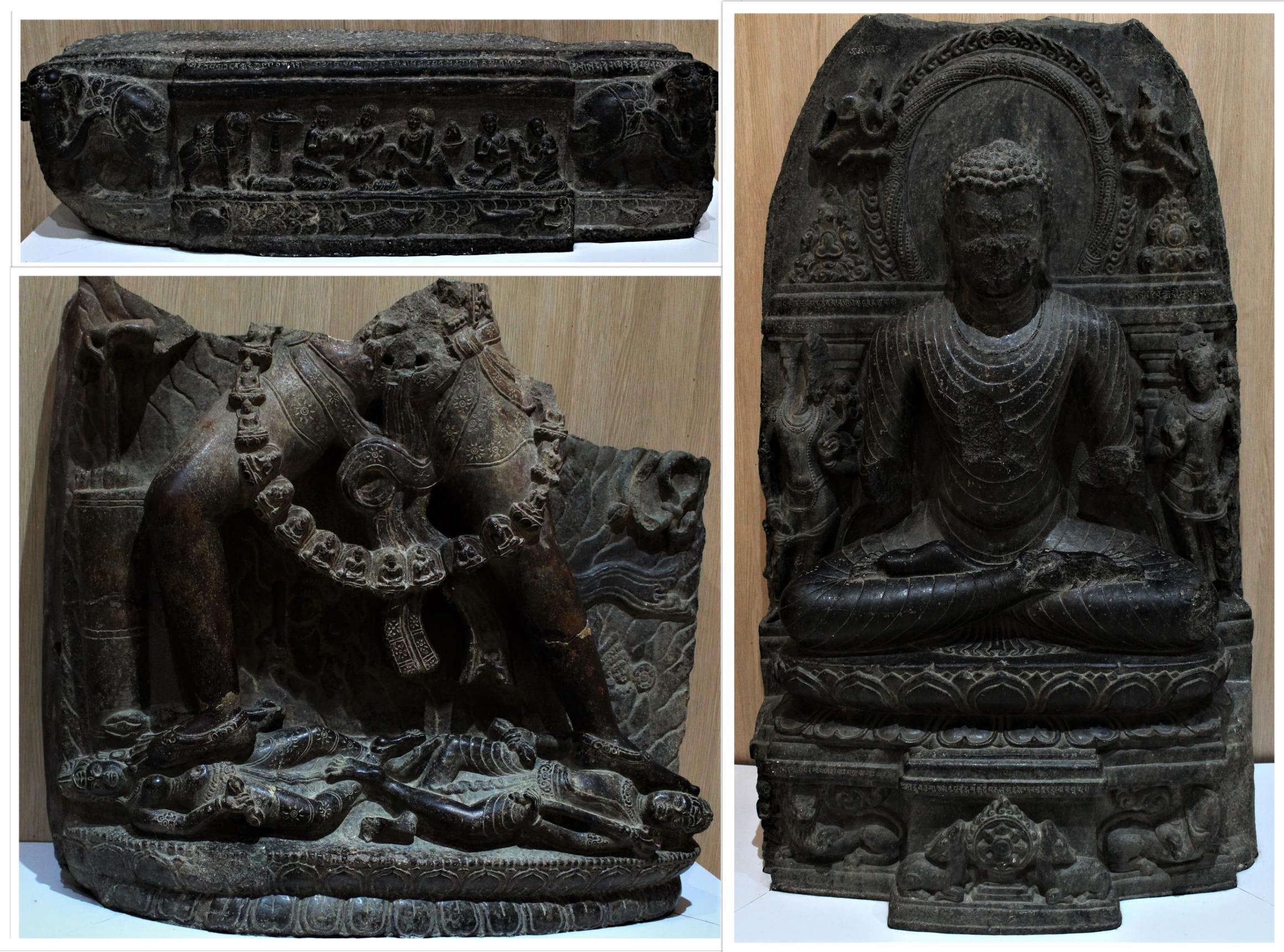
Top-Left: A Basalt Stone Panel (9-10th century CE); Bottom-Left: Trailokya Vijaya (11-12th century CE); Right: Buddha in preaching pose made of Basalt Stone (6th century CE). Sculptures obtained from the ruins of Nalanda University and preserved at Nalanda Museum. (Photographs taken with permission from the Museum).
PATRONAGE BY HARSHVARDHAN (606-647 CE)
After initial rounds of destruction, Nalanda was re-built by King Harshvardhan (606-647 CE). Seals of Harshvardhan have been discovered from the excavation, indicating his patronage for the monastery.
PATRONAGE BY PALA KINGS (8TH-12TH CENTURY)
A vast majority of stone and bronze sculptures at Nalanda are from the Pala period (8th-12th century). The Pala dynasty rose to power in eastern India, ruling much of modern-day Bihar and Bengal, in the 8th century. The Palas were Buddhist. Second Pala king Dharmapala (781-821 CE) and his successor Devapala (821-861 CE) are two important names in this context.
FINAL DESTRUCTION AND “END” OF NALANDA
The decline of this great institution started in later Pala period but the final blow came in 1193 CE by the invasion of Bakhtiyar Khilji. Almost every historian attributes the “end” of Nalanda to Bakhtiyar Khilji, Afghan military commander of Qutb-ud-din Aibak. The report on this invasion comes from the Persian history Minhaj al-Siraj’s Tabaqat-i-Nasiri. It reports that in 1193, Khilji organized an attack on the fortified city of Bihar and most of the inhabitant “bhahmans” were killed. Within the fortress there were many books and upon enquiry Khilji learned “that the whole of the fortress was a college”. There is, however, some confusion on whether Khilji ransacked Nalanda or some other monastery in Bihar Sharif. Whatever the case may be, it’s almost certain that his military invasion destabilized the region that in turn made very difficult for monasteries to survive.
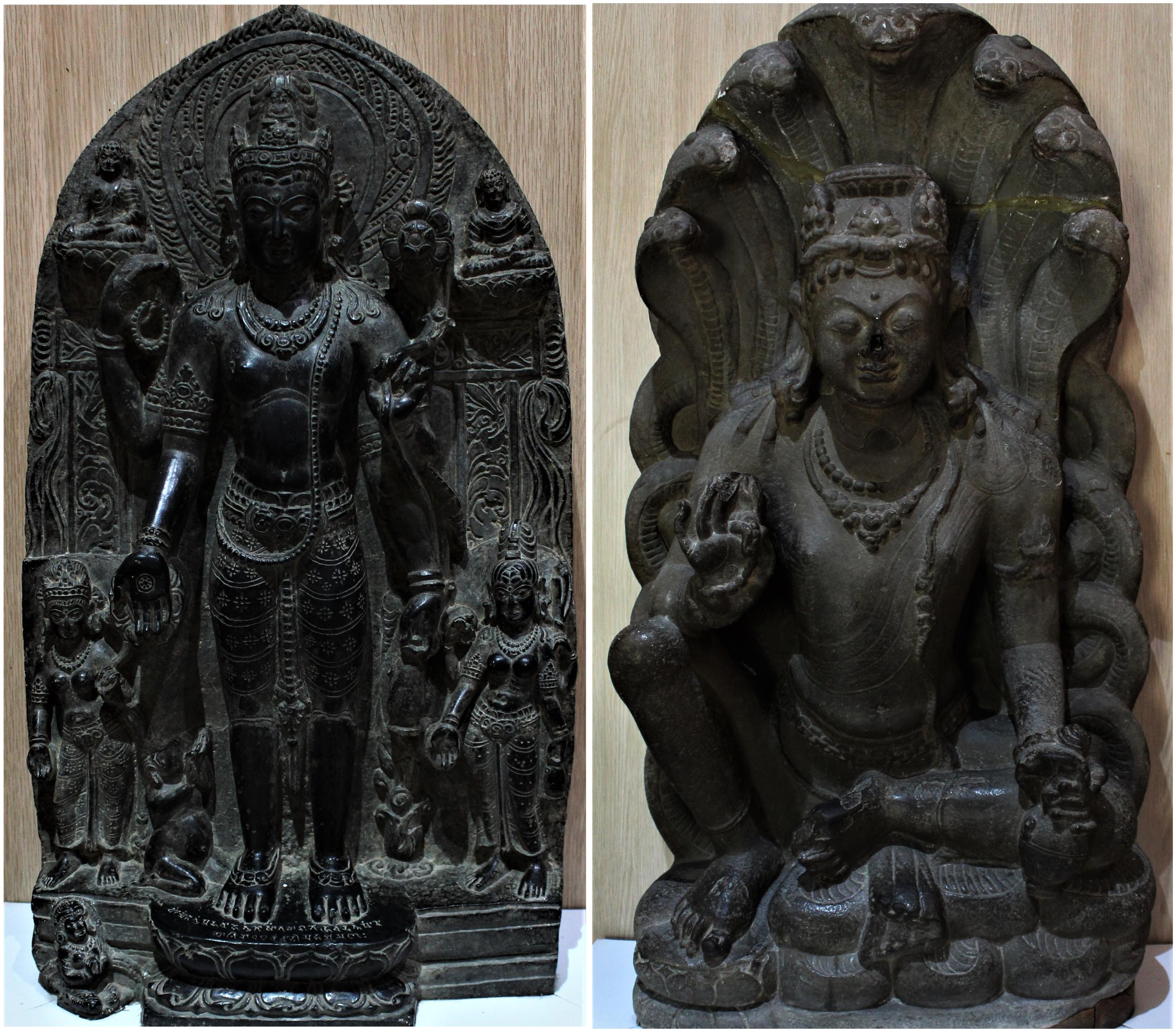
Left: Avalokiteswara (9-10th century CE); Right: Nagaraja (7th century CE). Basalt Stone sculptures obtained from the ruins of Nalanda University and preserved at Nalanda Museum. (Photographs taken with permission from the Museum)
SOME MIND-BLOWING STORIES ABOUT NALANDA
Below are some ‘stories’ about Nalanda, which will blow your mind away. However, these are widely disputed and don’t have significant historical base. Thus, we call these ‘stories’.
- The Great Library of Nalanda University was the largest and oldest library in the world. The name of this library was Dharma echo, which means the mountain of truth. There were approximately 10 million books in this library.
- The library was so vast that it took three months to burn after the invaders set fire to it, while ransacking the monastery.
- Gravity, what Newton discovered many centuries later, had already been discovered by the scholars of Nalanda university.
- Once, Bakhtiyar Khilji had fallen sick and the doctors in his court failed to cure him. Then, some people from his court advised him to get himself cured by Rahul Sri Bhadra, the principal of Nalanda University. At first Khilji, too proud of his Islamic culture, refused to get himself treated by a person of some other religion. But his health worsened and he was left with no other option but to invite Bhadra from Nalanda. Obviously, he had no belief in ‘Ayurveda’. He put a condition before Bhadra to cure him without any medicines or else he will be killed. Bhadra then asked Khilji to read some pages from the Quran and surprisingly Khilji’s health started improving and he was cured. Being jealous by the superiority of an Indian scholar than the hakims of his court, Khilji decided to destroy the roots of such knowledge from the country. So, he set fire to the great library of Nalanda.
- Some historians claim that Nalanda was destroyed not by Khilji, but by the Hindu Brahmins. They claim that Brahmins were jealous due to superior knowledge of the Buddhist and they had to compete with the Buddhist for grants from the Kings. This seems to be untrue, even going by common sense. (1) On one side - you have Hindu Brahmins, who co-existed with the Buddhists for more than a millennium and then suddenly in 1193 (when Nalanda was at its last stage) they realized that Buddhists and monasteries were creating problem for them and thus should be destroyed. (2) On the other side - The year 1193 was the very next to the year in which Prithviraj Chauhan lost to the Muslim invader Mohammad Ghori in the battle of Tarain (1192). It was followed by massive plunder by Ghori and his generals and the year also marks the start of Sultanate rule in Delhi under Qutb-ud-din Aibak, one of the slaves of Ghori who became the first Sultan. Bakhtiyar Khilji was military commander of this Qutb-ud-din Aibak. Now, who might have destroyed Nalanda…you decide.
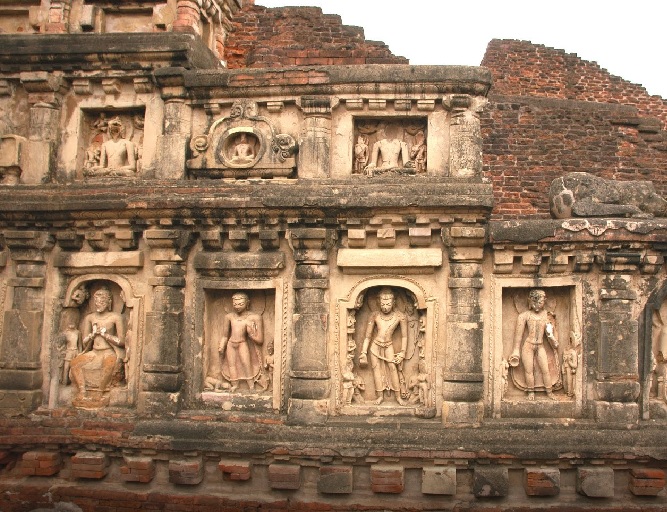
“Nalanda along with nearby tourist spots like Rajgir, Pawapuri, Gaya, Bodhgaya and Barabar caves can be covered in 4-5 days comfortably”
HOW TO REACH NALANDA
You have to reach Patna / Gaya / Bakhtiyarpur first.
The nearest Airport is Patna, which is the capital of Bihar State. You can reach Patna by train also. Alternatively, you can reach Gaya by train. Both these stations are very big, and all the major trains between Kolkata and New Delhi either go through Gaya or Patna. It depends where you are coming from. People coming from Kolkata or eastern side should go to Gaya, since it’s closer. People coming from Northern side may choose Patna. Gaya also has a very small Airport, but only a limited number of flights operate from there and it’s not recommended.
People may also think of going to Kolkata directly by flight. From Kolkata there are numerous overnight trains which would reach Gaya in the early morning (Some would prefer going to Bakhtiyarpur Station, but as per my opinion Gaya is preferable as it’s bigger and cabs availability are higher).
Once you reach Patna / Gaya / Bakhtiyarpur, you have to hire a cab.
- Patna to Nalanda distance by road is 75 kms and would take around 1.5 hours
- Gaya to Nalanda distance by road is 90 kms and would take around 2 hours.
- Bakhtiyarpur to Nalanda distance by road is 30 kms and would take 45 minutes.
There is a Railway Station at Rajgir itself with very few trains running. Do not avail those as those are kind of local trains and would waste your time.

ITINERARY
Normally people do not go to Nalanda only, but club it with other places nearby viz. Rajgir, Pawapuri, Gaya, Bodhgaya and Barabar caves. You can complete the entire tour in 4-5 days, with Rajgir (1-2 days), Bodhgaya (1 day), Nalanda and Pawapuri together (1 day). Gaya and Barabar caves will take another day. Staying arrangement can be done at Rajgir, which is just 15 kms from Nalanda. Alternatively, you can stay at Bodhgaya. Both Rajgir and Bodhgaya have plenty of Resorts and Hotels of various price ranges.
- Rajgir (15 kms from Nalanda) has a very old History. It was the capital of ancient state of Magadha when Patliputra was not formed i.e. it’s history dates back to Bimbisara and Ajatsatru of Haryanka Dynasty around mid of 6th century BCE (Pre-Mauryan era).
- Pawapuri (25 kms from Nalanda) is a village in Nalanda District only and is a holy site for the Jains. It is the place where remains of Lord Mahavira was cremated. There is an excellent temple in the middle of a lake called Jalmandir, which is worth visiting.
- Gaya (90 kms from Nalanda) is a holy site for the Hindus.
- Barabar Caves (80 kms from Nalanda), located in Barabar Hills is a set of 4 caves dating back to 3rd century BCE. The set of caves is one of the oldest rock-cut caves in India and most probably was hewed during the reign of Mauryan Empire Ashoka.
- Bodhgaya (70 kms from Nalanda) is the site of Buddha’s enlightenment and carries a special attraction for Buddha pilgrims from all parts of the world. It’s a small, neat and clean town with number of colourful monasteries, pagodas etc.
REFERENCES (FOR HISTORICAL INFORMATION)
- Nalanda: Situating the Great Monastery, Frederick M. Asher
- Encyclopaedia Britannica (https://www.britannica.com/)
- Google Arts & Culture (https://artsandculture.google.com/)
Photographs, unless otherwise credited, are self captured.
পড়ে খুব আনন্দ পেলাম
Indeed, being an ardent reader of Indian History, it was a joy reading this article. Author has brilliantly placed a delightful thought provoking article in front of readers, by mixing all the ingredients in a proper proportion. It is not an easy job to describe any ancient Indian architectural wonders, and the job of describing Nalanda University, among the crown jewels of ancient Indian Education system is hard as Nalanda demands special attraction from both the author and the reader. Undoubtedly, author is able to grab the attention of readers’ mind while reading the article. A heartwarming story, and information on other visiting places around Nalanda are icing on the cake.
Thanks…please do share your views in the comments section..
Thank you. Just started blogging one month back and I need this kind of encouragement. Please do forward to others also.
Simply superb….I will make my son who is 11 go through this Blog…Beautiful pics and well researched article….